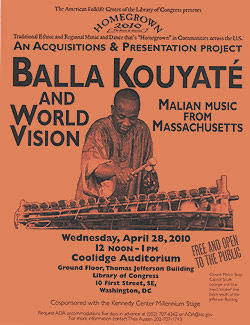| |
|||
|
The American Folklife Center at the Library of Congress presentsThe Homegrown 2010 Concert Series
|

|
To say that Balla Kouyaté was born into a musical family is an understatement. His family lineage goes back over eight hundred years to Balla Faséké Kouyaté, the first of an unbroken line of djelis (also known as griots) in the Kouyaté clan. Members of this family are regarded as the original praise-singers of the Mandé people, one of the ethnic groups found across much of West Africa. Djelis are the oral historians, peacemakers, musicians, and performers who are born into the responsibility of keeping alive and celebrating the history of the Mandé people of Mali, Guinea, and other West African countries.
As we will hear today, Balla's family instrument is the balafon. Considered the predecessor of the xylophone and the first Mandé instrument, the balafon is made up of wood slats of varying lengths. The slats are secured over two rows of calabash gourds, which serve as natural amplifiers. Each gourd is punctured with small holes over which Balla places thin plastic tape. The vibrating air rattles the plastic to create the desired sound. Were he back home in Mali, Balla would use spider webs (collected from kitchen walls) to cover the holes. The first known balafon dates back to the 13th century and remains under the guardianship of the Kouyaté family. It is considered a UNESCO-protected Masterpiece of the Oral and Intangible Heritage of Humanity. Once a year it is brought out and played during a ceremony.
Ethnomusicologist Ryan Thomas Skinner says this of Balla Kouyaté, ". . . he is one of the most remarkable exponents of that instrument that I have ever come across - a true virtuoso. He's also a very humble young man, soft-spoken, reticent in some ways, but he says enough through his musicmaking." Indeed, instruments played within this music tradition are said to "talk," an idea shared by many African American folk musicians. There are other parallels between West African and Black American music, such as the use of work songs to motivate physical labor. Balla tells the story of playing for workers in the field as a young teen in Mali. It was harvest time, and the owner had requested the family's services. Balla's mother sang while he played the balafon. They had placed him up on a rock, so the agricultural workers could see, as well as hear, the music above the tall crops. The men hoed in unison to the sound of the music. "Ten or fifteen guys all doing this at the same time as I'm playing the music. We would do that for four or five hours a day. . . . so that will really motivate them even more, calling 'Hoo!' just like they're so happy to do what they're doing." Balla explains that if they did this for all of the harvesting season, by the end of the harvest, they would be given six months of food - peanuts, corn, and manioc.
"In my culture, music is used primarily to encourage people." True to his word, Kouyaté frequently performs at weddings, baptisms, and other domestic ceremonies within the West African immigrant communities of Boston, New York City, and beyond. To have him present at such celebrations is a way of bringing together a community far from home, reminding them where they came from, holding the culture together. "We always believe you know where you are heading to, if you know where you came from. That's why the family history is very important to us."
Balla is equally motivated to share his music with the larger world, driving the tradition forward. In his group, World Vision, he fuses tradition with more modern influences, echoing the Afropop music of present-day Mali and Guinea. He released Sababu: Balla Kouyaté & World Vision in 2007, and he regularly plays with world renowned West African musicians who are touring in the States. He often accompanies Grammy-winning kora master Mamadou Diabate, and in 2004 joined NEA National Heritage Fellow Sidiki Condé for a month long residency at Carnegie Hall. In 2010, Balla Kouyaté was awarded a Massachusetts Cultural Council Fellowship in the Traditional Arts. Today, he performs with singer, Adjaratou "Tapani" Demba, Sekou "Pablo" Dembele, Makane Kouyaté, Idrissa Koné, Daniel Day and Raja Kassis.
FOR FURTHER READING:
Eric Charry, Mande Music: Traditional and Modern Music of the Maninka and NMandinka of Western Africa, Chicago: University of Chicago Press, 2000.
Afropop Worldwide's program "New York's Mande Diaspora, Part 2: Beyond Community," ![]() Banning Eyre interviews Ryan Thomas Skinner, 2009.
Banning Eyre interviews Ryan Thomas Skinner, 2009.
The Cultural Space of Sosso-Bala ![]() [Balefon], UNESCO, Inscribed in 2008 on the Representative List of the Intangible Cultural Heritage of Humanity.
[Balefon], UNESCO, Inscribed in 2008 on the Representative List of the Intangible Cultural Heritage of Humanity.
Maggie Holtzberg, Ph.D.
Boston, Massachusetts, 2010
 The American Folklife Center was created by Congress in 1976 and placed at the Library of Congress to "preserve and present American Folklife" through programs of research, documentation, archival preservation, reference service, live performance, exhibition, public programs, and training. The Center includes the American Folklife Center Archive of folk culture, which was established in 1928 and is now one of the largest collections of ethnographic material from the United States and around the world. Please visit our web site.
The American Folklife Center was created by Congress in 1976 and placed at the Library of Congress to "preserve and present American Folklife" through programs of research, documentation, archival preservation, reference service, live performance, exhibition, public programs, and training. The Center includes the American Folklife Center Archive of folk culture, which was established in 1928 and is now one of the largest collections of ethnographic material from the United States and around the world. Please visit our web site.
| ||||
